Artistic director: Mareen Alburg-Duncker
Special school “Astrid Lindgren” in Halle

SEA MOSAIC: Year 8 pupils created a sea mosaic, with the theme of marine life being illuminated from all sides. In addition to the creative approach and implementation, it was important to me to make the children aware of the topic of environmental protection. Our aim was to create an intact underwater world in all its diversity – a sea mosaic!
Plant and animal shapes were drawn on poplar wood, sawn out and decorated with mosaic stones. Animal by animal, the mural filled with life. The children worked with the materials and tools in the new technology with enormous enthusiasm and patience.
Artistic direction: Claudia Baugut
Levana School Eisleben
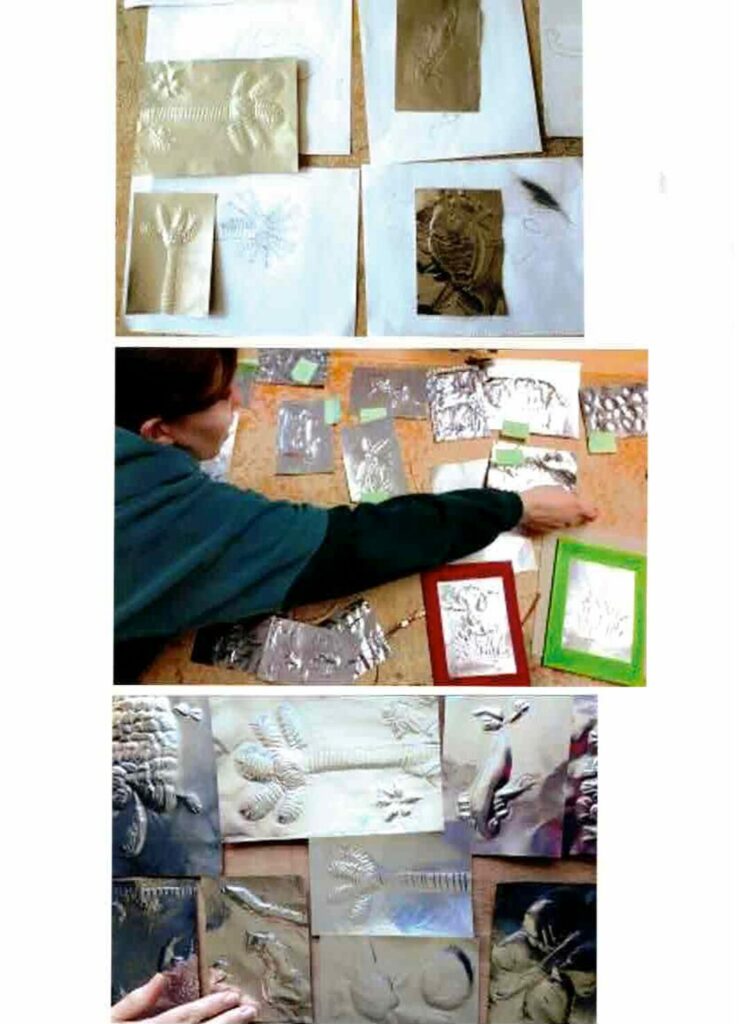
Theme: FLORA UND FAUNA – A relief
Plant books, animal encyclopedias, photos by Carl Bloßfeld and drawings by Ernst Heckel deliberately formed the basis for the preparatory work. The technical implementation in a metal relief requires spatial thinking, abstraction and craftsmanship.
With the help of wood and metal tools, on hard and soft surfaces, first the contours were created, then the plastic shaping on the front and back of the aluminum sheet.
For pupils and teachers, this was a new, marveled at dimension of design.
Joined together to form a large relief, the works are given a beautiful place in the school building.
Artistic direction: Michela Benedan
Salbe elementary school in Magdeburg
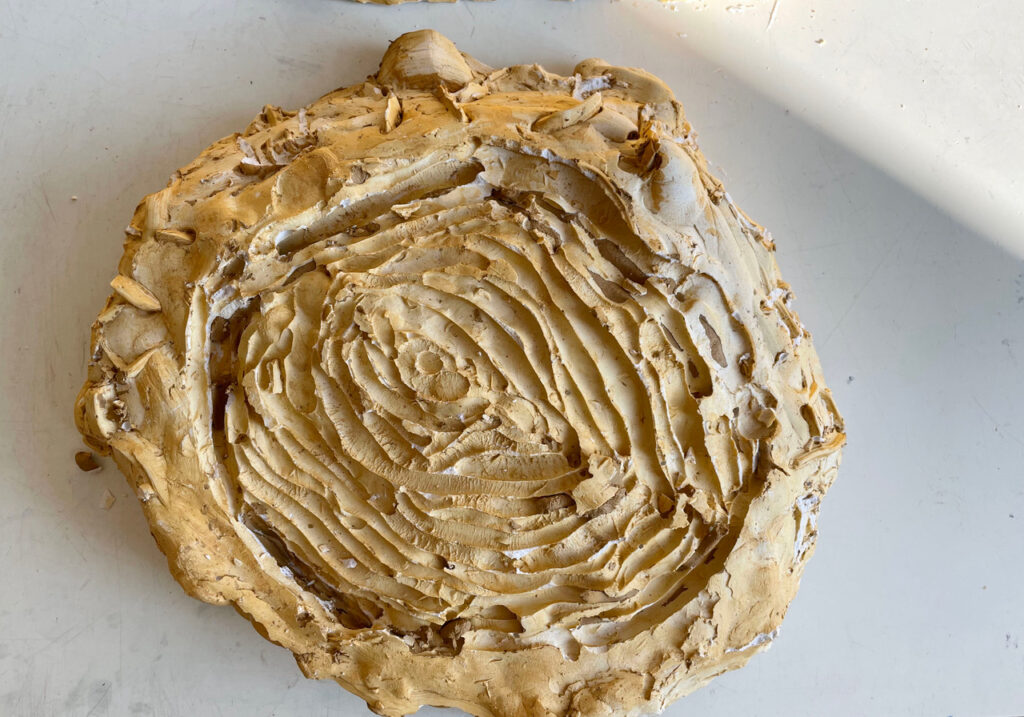
The children worked together in small groups on the project, carving large, solid slabs of clay and hollowing out material. At the end, plaster was poured into the hollow mold. This resulted in various reliefs of a district.
The process can be described by the following questions: What happens when you add material to the hollowed-out mold? What happens if you carve even deeper and remove material with different tools? What does the plaster mold look like in the end?
Artistic direction: Christiane Budig
Elementary school “Am Mühlberg” in Hohenthurm
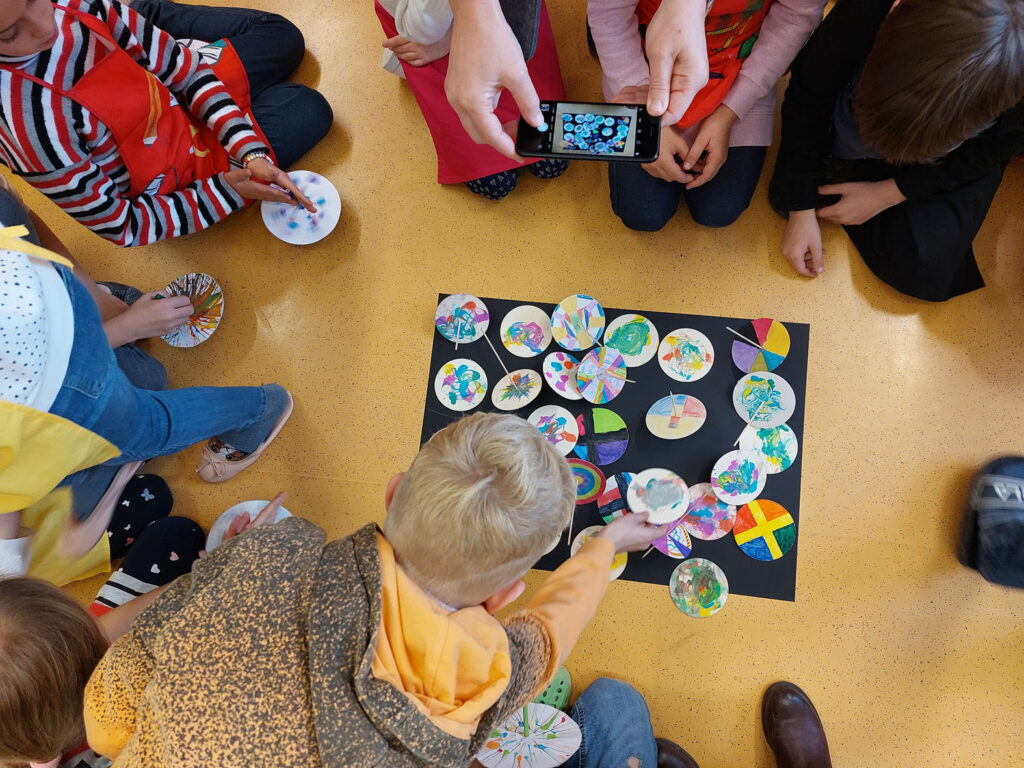
“In Balance” Color and form in motion/the creative use of ink and poster paint
As making spinning tops was very popular last year, I offered the pupils the opportunity to make their own spinning tops again this year.
In addition to building spinning tops of different sizes, I showed the pupils various random methods, which they completed graphically with a drawing pen. Here the pupils gave free rein to their creativity, creating underwater worlds, monsters and fantasy animals, among other things. I really enjoyed seeing the children creating freely during the project and especially during the spinning top competition at the end of the project.
Artistic direction: Harriet Bünning
Borlach Community School Bad Dürrenberg
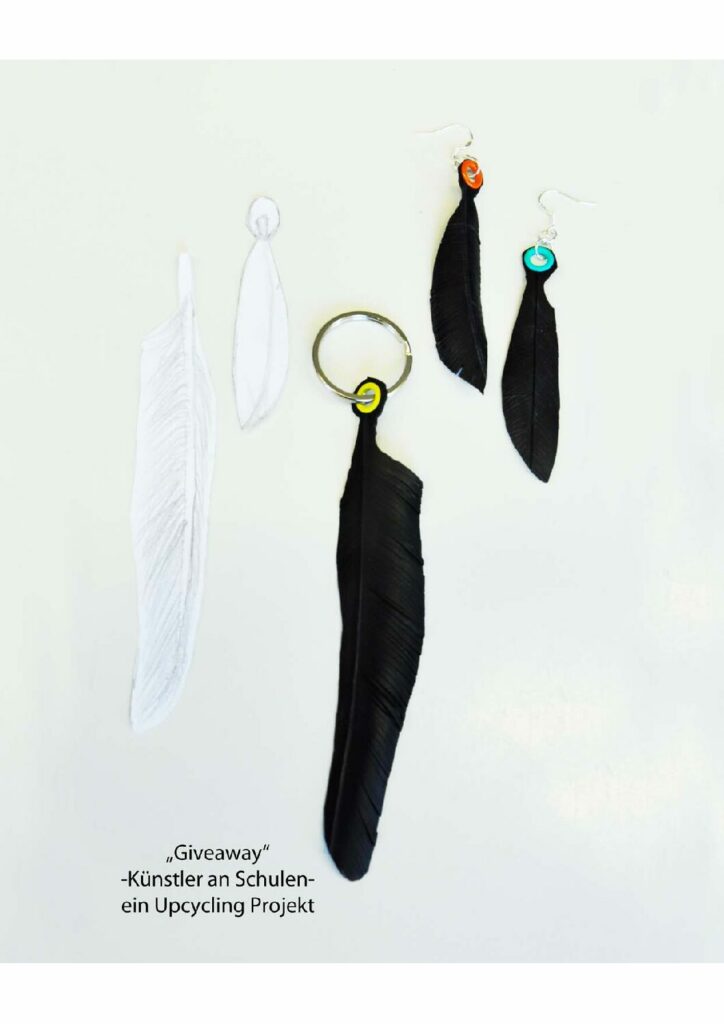
The pupils produced a “giveaway” from an upcycling material in the “The Feather” project. We used broken and discarded bicycle inner tubes for this. These are waste and have been transformed by the students into a product as good as new, redesigned and artistically staged. The result-oriented, practical and artistic work was a lot of fun for the students.
Artistic direction: G.Burkard Büttner
Elementary school in Bad Schmiedeberg
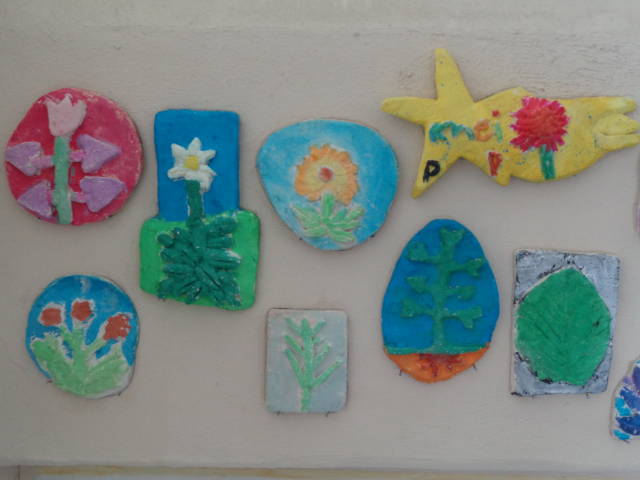
The children studied their favorite medicinal herbs from the elementary school’s Kneipp garden according to the criteria of taste, smell, shape, color and special features of use. In this way, each child found an individual and emotional approach to the Kneipp art project.
This was reflected in a large number of detailed drawings with the typical characteristics of the respective plant. During the nature study time in the Kneipp school garden, the children were able to sharpen and train their perception and observation from an educational and artistic point of view. In this way, the young artists’ drawings grew and formed the basis for a three-dimensional work in clay. The children were able to translate their learning outcomes from observation and memory from the two-dimensionality of the drawing into the three-dimensionality of the clay relief. Low and high reliefs were created, depending on the children’s preferences and expressions.
The sculptural results of the children’s artistic work were transferred to plaster and then individually colored. Each child was able to realize a design close to the model of nature or rather in the symbolism and expressiveness of color according to his or her individual point of view and preference. This led to a joint wall design in the stairwell of the Bad Schmiedeberg elementary school.
Artistic direction: Josefine Cyranka
J.-W.-v.-Goethe secondary school in Ilsenburg
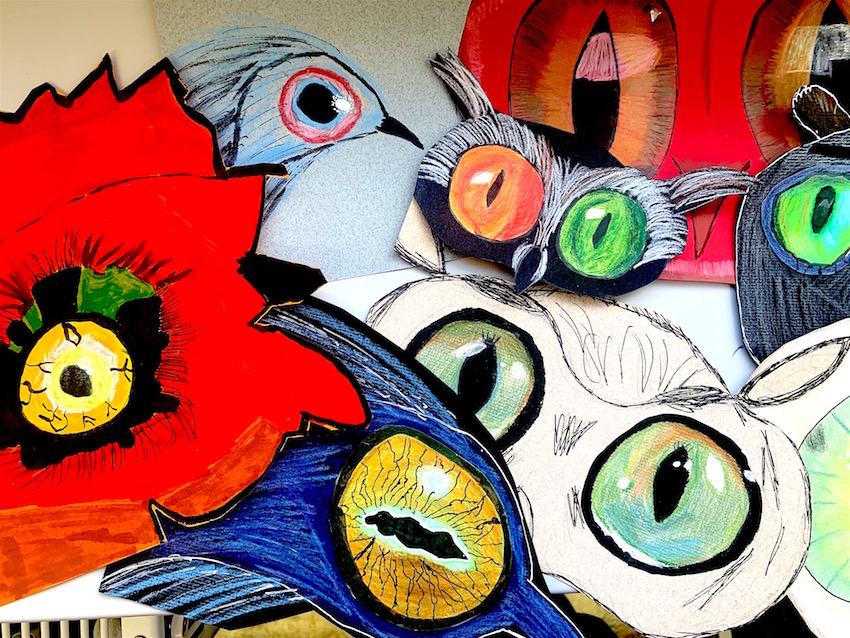
“Weird bird” We look animals in the eye. There are pupils, eyelids, eyelashes, eyebrows, dark circles and wrinkles in all colors and a look. This speaks to us and is an essential means of illustration. We draw oversized eyes with a brush pen and fineliner on tinted paper and add them to bird heads. We experiment with colors on watercolor paper and cut a bird’s body out of it. We playfully and effectively bring the two together and fix one version as a collage.
Artistic direction: Anne Deuter
Halle-Nietleben elementary school

BUCHbar – from A for awl to M for marbling to Z for magic book
14 pupils from Nietleben elementary school went on a book and print art journey of discovery during the 2022 fall break. If you wanted to learn how not to wrap paper with thread around your fingers and how to implement simple printing techniques, the BUCHbar was the place to be.
Together we explored the questions of how individual sheets of paper are turned into a book, how marbled paper can be created with the help of shaving foam and ink, how to develop a stamp yourself and why it sometimes takes so long.
Artistic direction: Micha Gebhardt
Burggymnasium in Wettin
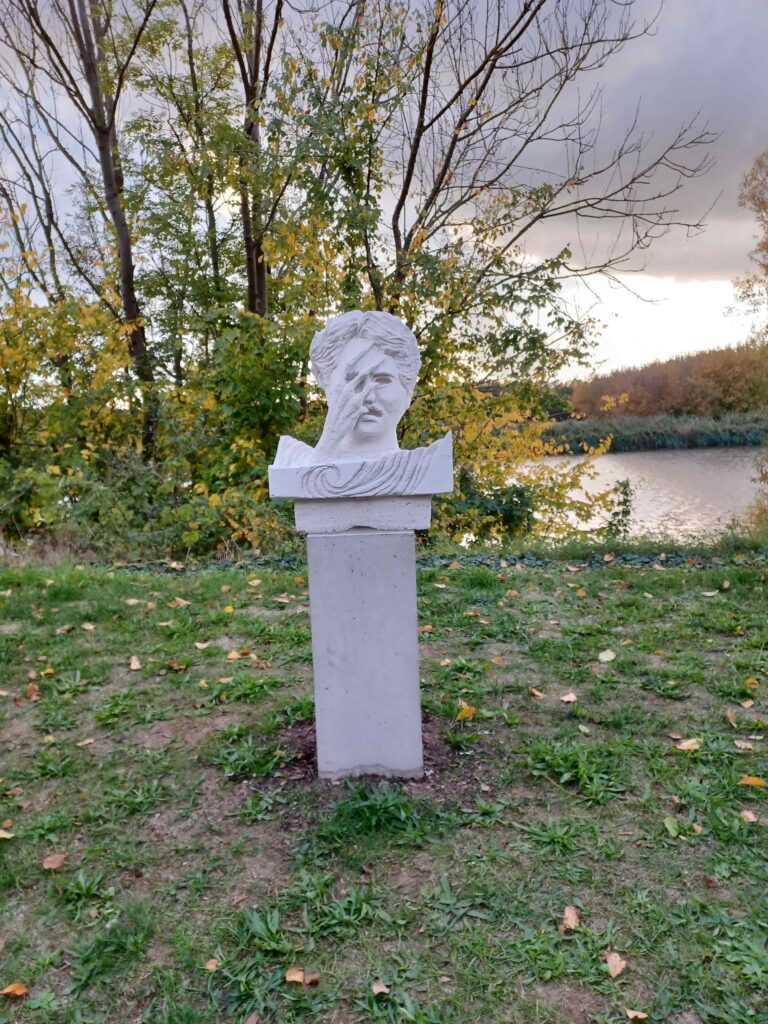
The project “Legends turned to stone” made reference to the historical town of Wettin in the Saale district. Wettin’s impressive story is part of the rich world of legends. ü handed down.
The real places where these legends take place can still be found today around Wettin and along the Saale. The shü pupils and students ü of the Burggymnasium Wettin n ä approached the topic ü and created their own sculptures from aerated concrete blocks.
They have been permanently installed in a park of figures along the Saale cycle path. The sculptures tellä tion of the legendary world of Wettin as part of the cultural memory ä of the town and the region, which the Ö public as “ legends turned to stone”.
Artistic direction: Katharina Günther
Großörner elementary school, Mansfeld

For weeks, the children in Year 4 at Großörner elementary school have been working on the subject of “masks”. The aim was to build a three-dimensional mask out of wire and paper and to implement the sketches. The project started during the carnival season and so I looked at the history and origins of masks around the world with the children.
What does the mask do to me when I wear it? The disguise of the person through the mask, transforming the person into something completely different: Hero, mythical creature, animal or hybrid creature could be experienced by the children.
Artistic direction: Sebastian Harwardt & Julia Baum
Albrecht Dürer” secondary school in Merseburg
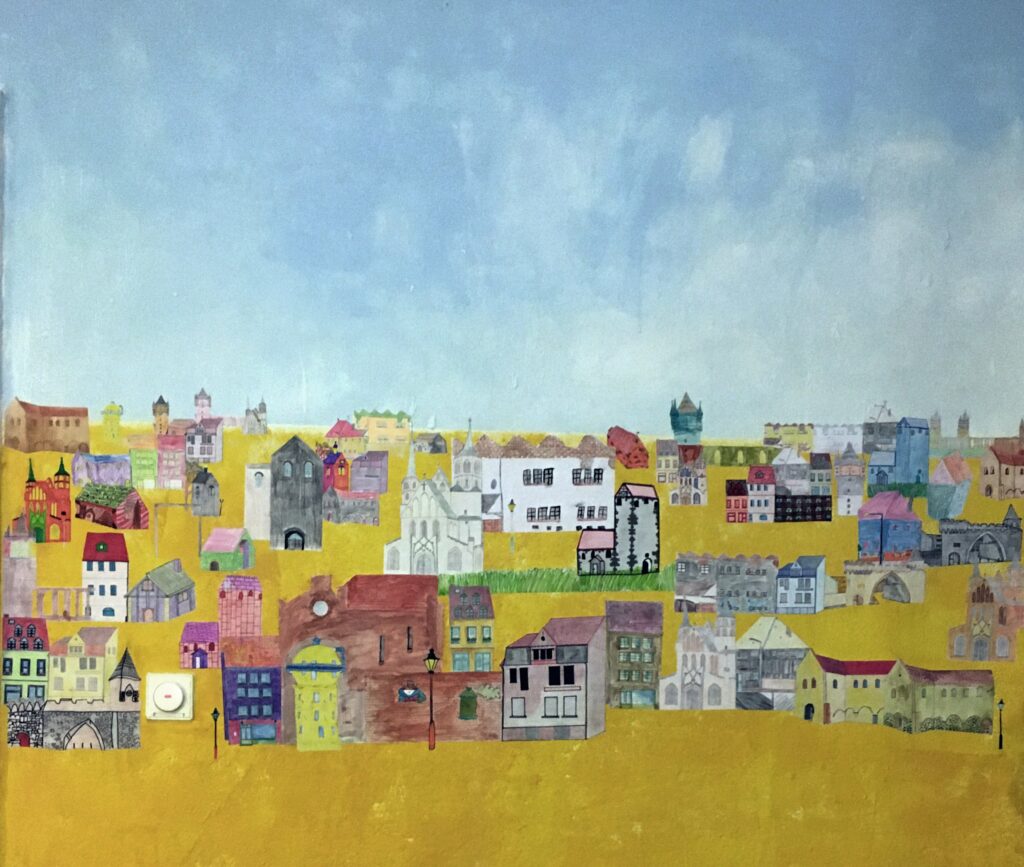
As part of “Artists in Schools”, a drawing and collage course led by Sebastian Harwardt and Julia Baum was held at Merseburg’s “Albrecht Dürer” secondary school in November 2022. 24 students from a ninth grade class took part. The group was divided, which enabled successful implementation.
The content of the project was the artistic realization of views of the city of Merseburg. Beforehand, the students collected impressions and photos of buildings and details. They drew them during the course. The drawings were copied and further colored by the pupils. They were free to choose the materials. The results were then cut out and glued directly onto the wall.
Artistic direction: Carola Helbing-Erben
Elementary school in the castle in Ostrau
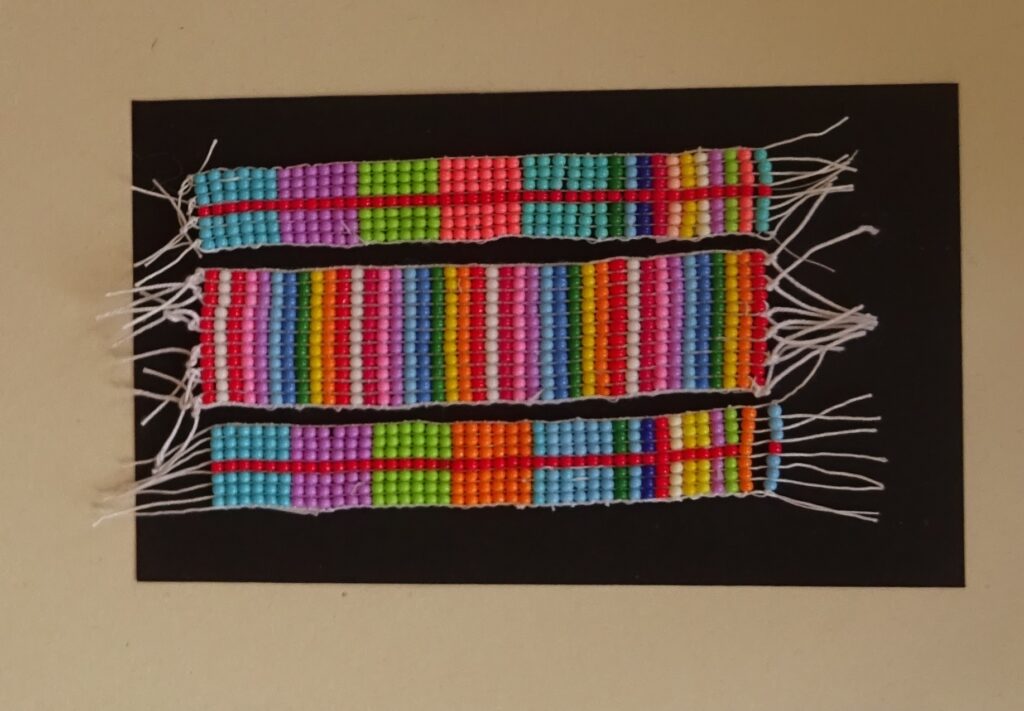
Today we know bead weaving more or less from the craft sector.
Patience and dexterity are required to produce a piece of work.
The children decided to do this work. No one had ever heard of bead weaving before.
Bead jewelry and bead weaving play an important role in various cultures, in the past and today, for example in Indian, African and Indian cultures. Jewelry as a fashion detail but also as a ritual symbol. The children learned this with the help of picture examples. In the practical part, design exercises for creating patterns were an essential basis for achieving a good initial result.
The more confidently the children learned the technique of bead weaving, the more joyfully they approached this work. The small carpet, consisting of three strips of pearls, was lovingly framed and was intended as a gift for the parents.
Artistic direction: Holtrud Henze
Elementary school in the castle in Ostrau
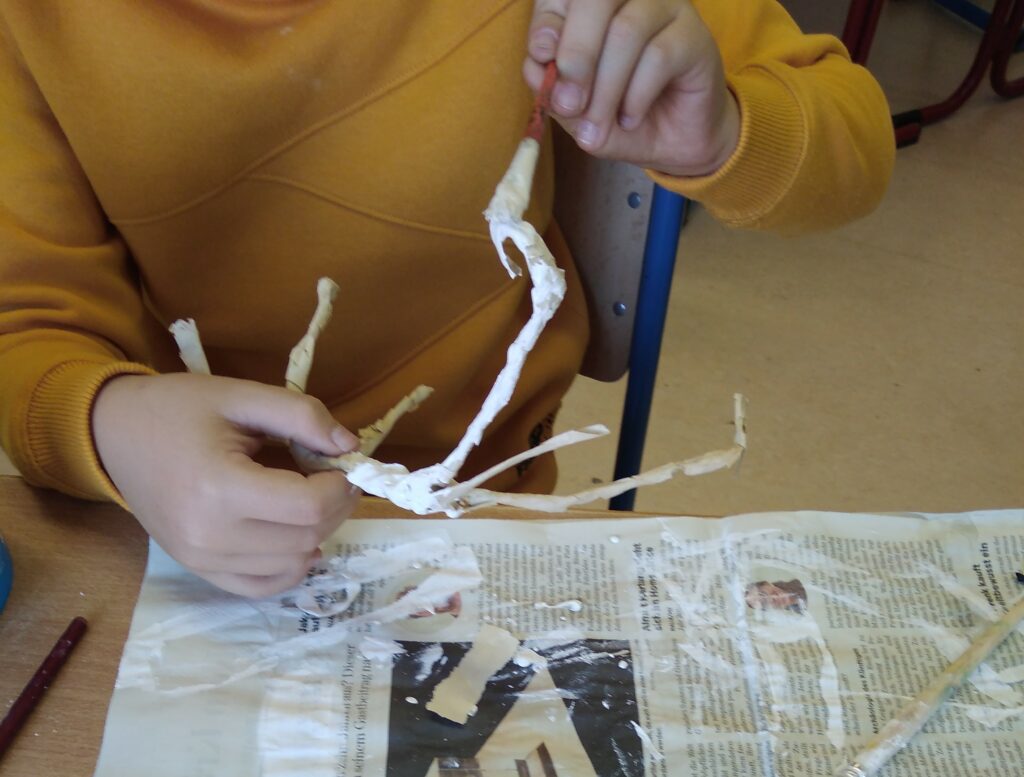
“From line to figure” Designing with wire and paper
In the introduction, students learn the basics of sculpture using examples from art history. Together we will look at well-known sculptures from the Halle area and talk about their technique and their effect. Our project will then be presented.
Based on the large models, small figures such as stick figures are to be bent and formed from wire. These figures can be playfully brought into different postures. Body language is used to shape very different topics, whether working on the computer, playing soccer or lazing around on a summer vacation. The small figures must now be further stabilized with wire. The resulting mesh is then wrapped in paper, glued on and painted. In keeping with the theme, the figures are given matching accessories. Finally, the small ensemble is placed on a self-built pedestal where it can unfold its full effect.
Artistic direction: Silke Hönig
Elementary school in Salzmünde
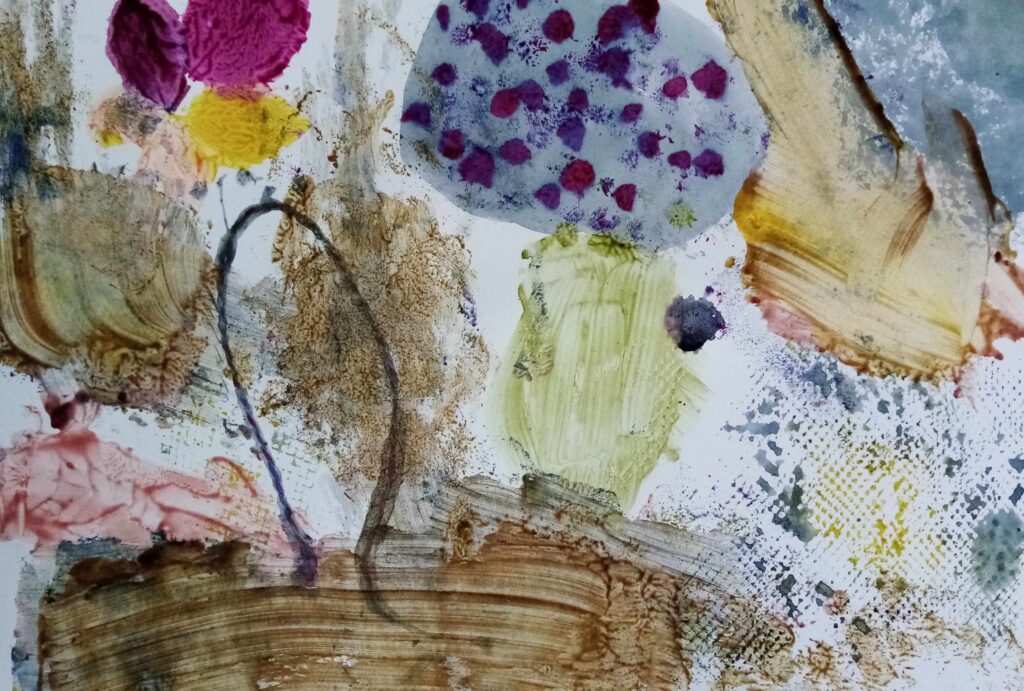
Plant paint workshop The art project for 3rd grade students included a workshop over 2 times 2 days on the production of paint from natural plant raw materials and their artistic application on various topics. Seasonally available fresh and dried parts of cultivated and wild plants were used.
The color-giving properties of flowers, vegetables, fruits and herbs were discovered with all the senses. The juice paints produced were further processed with various natural binders to make paste paints and egg tempera paints. Wet-on-wet watercolor painting, opaque egg tempera painting and monotype/material printing using paste colors were tested and applied.
They painted, wrote and drew with brushes, goose quills and bamboo feathers. Plant-dyed Japanese papers were used for collages. The joy of experimentation was particularly stimulated by the possibility of pH-dependent color changes through appropriate additives.
Artistic director: Jan Herzog
Protestant elementary school “Martin-Luther” in Oppin
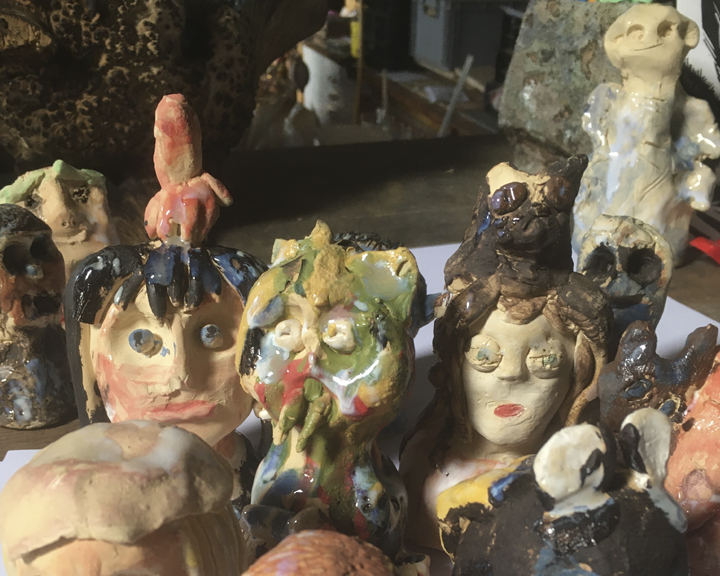
The character head. Heads and stories are created on the page as well as in the children’s heads. Drawings, sketches in ink and colored pencil. Modeling in clay and painting with engobes, first sculptural experiences, countless little oven spirits are created. Colorful, powerful stories are behind every small sculpture and give children free access to artistic narratives and their first experiences in sculptural design.
Artistic direction: Suse Kaluza
Elementary school “Ottfried Preußler” Halle
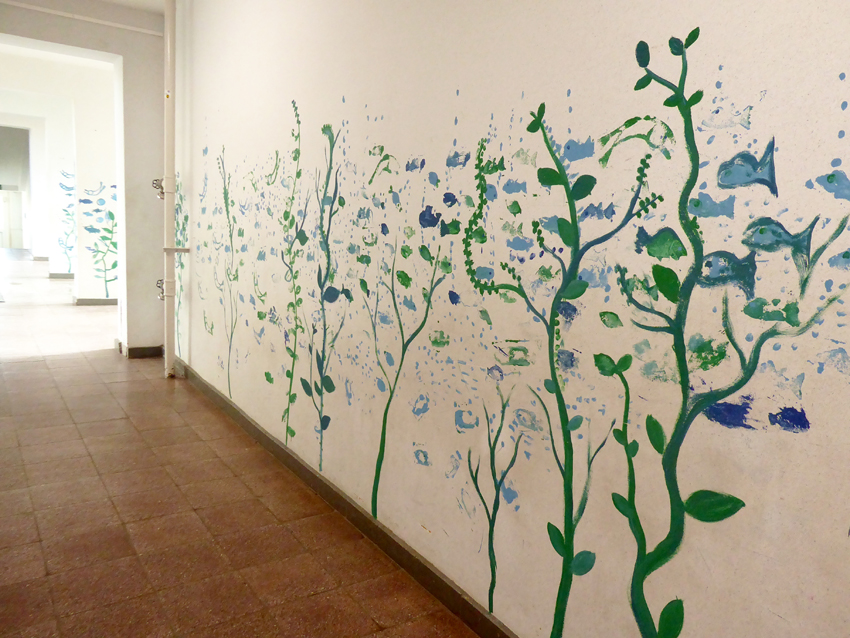
At the “Ottfried Preußler” elementary school in Halle (Saale), several corridor areas were decorated with self-made stamps. Two 1st and two 3rd graders made lots of little stamps based on the stories “The Little Water Sprite” and “The Little Ghost”. Using a simple stamping technique, the previously monotonous and somewhat dreary school corridors were transformed into colorful, lively story worlds.
Artistic direction: Wiebke Kirchner
Learning Center Halle-Neustadt
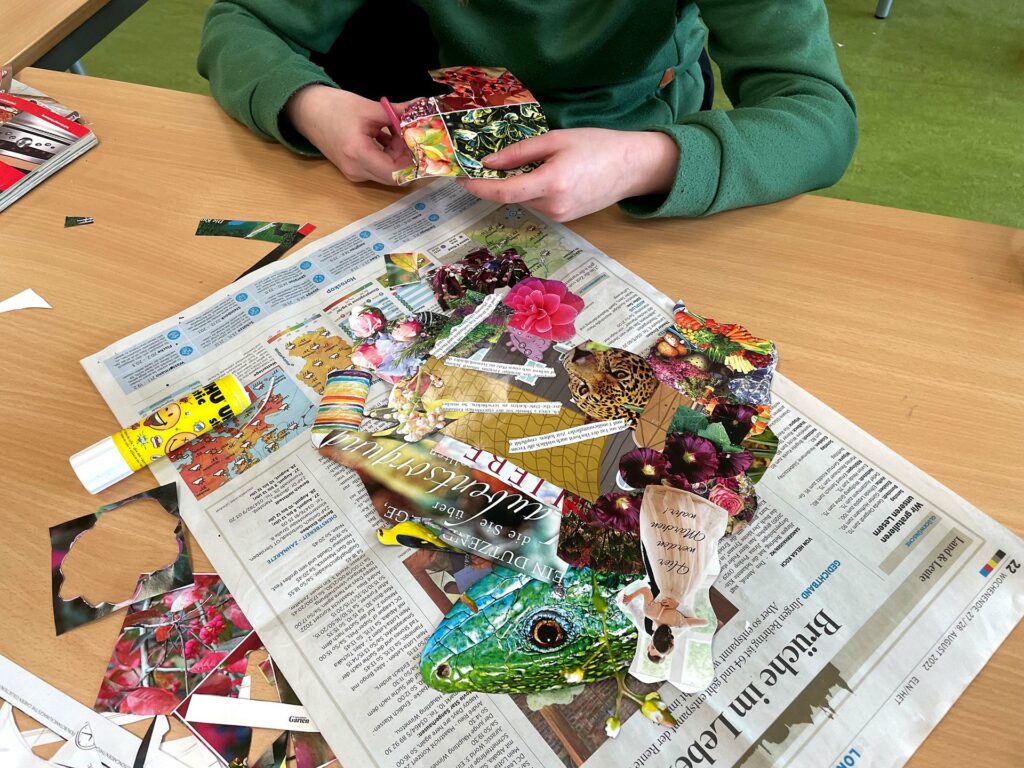
The starting point of the multi-day school project by artist Wiebke Kirchner with pupils from the Halle-Neustadt learning center was that each child could express their individuality and cultural preferences in free paper collages. These pictures were put together to create a large collage with a WOW effect. After consultation with the school management, the resulting work will be used as a fabric print to impressively and colorfully shade the seating area in the schoolyard during the summer.
Artistic direction: Thomas Kober
Alfred-Wirth elementary school in Osternienburg

Since I was scheduled to teach two of the first classes, I re-planned my submitted cyanotype concept and prepared simple printmaking techniques with basic geometric shapes and the primary colors red, yellow and blue. Over four days, the children were able to explore the themes of printmaking and color mixing using various objects such as paper plates, wooden building blocks, autumn leaves, smooth surfaces and ear sticks.
Artistic direction: Juliette Kolberg
Special school “Lebensweg” in Bernburg

This school year, 12 young people from the special school “Lebensweg” in Bernburg had the opportunity to find various well-known animals and plants whose figurative names can trigger different shapes and ideas. They collected terms such as: Daisies, lemon butterflies or foxtails and used them to search for their own fantastic invention of the right shape for the word.
Artistic direction: Susanne Langbehn
Glaucha elementary school in Halle

In the afternoon lessons, 12 pupils from the 3. and 4th grade a suitcase or a small box. They talked together about what is or could be a nice or interesting place in the school. Or what an island can be in a figurative sense.
The children develop objects that they could put in their boxes that are or could be important to them in some way. In addition to learning techniques for air-drying clay or papier-mâché, the focus is also on losing the fear of result-oriented works of art through joint discussions and at the same time looking for solutions together when one thing or another has not worked out as expected or planned.
However, the aim was not necessarily to have to present a case/box or object. Afternoon lessons should also be an opportunity to try things out without the pressure of assessment. The focus on repetition and experimentation until the respective child is satisfied with the object or picture was elementary. Which could also mean that at the end of an hour, the clay was sometimes softened again with water and squeezed unrecognizably into a lump. The internal process became more important than a presentable result.
Artistic director: ilka Leukefeld
Lakomy School in Halberstadt
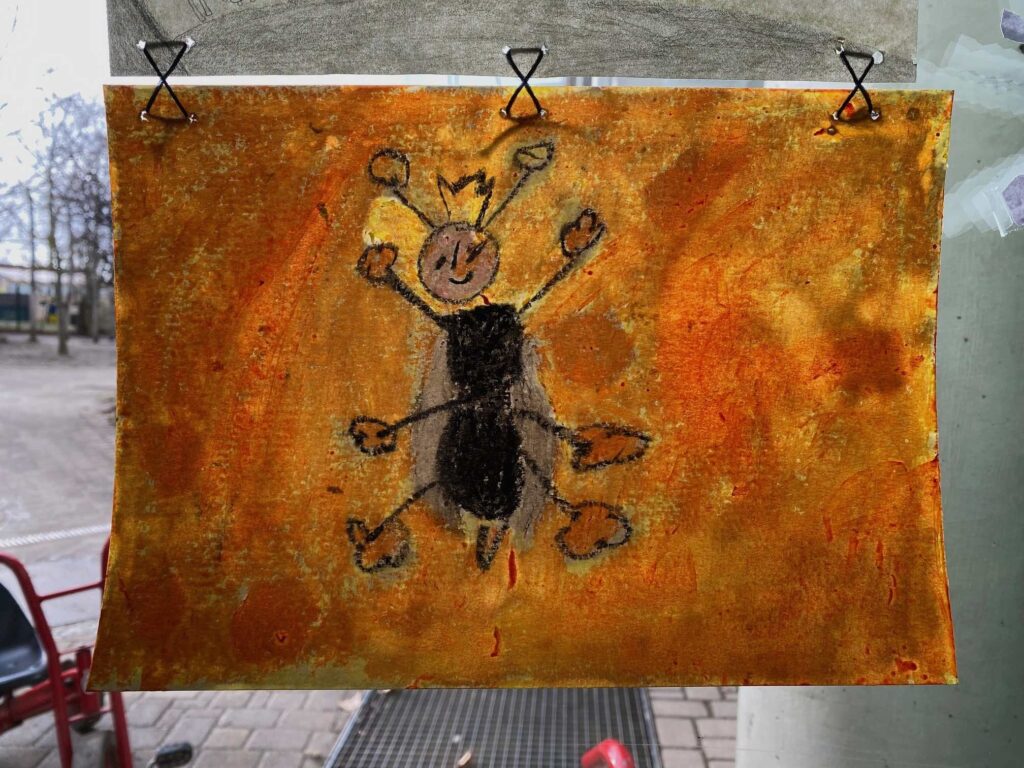
“My strengths”
The nine children in learning group 5b at Lakomy School had the opportunity to explore their own inner strengths with a lot of imagination under the guidance of artist Ilka Leukefeld. Through the meditative QiGong exercises, the topic of “movement and stillness” was also practiced with a lot of fun.
Using colored, environmentally friendly bee wax blocks, they drew selected motifs from their previously created sketches (words and pictures). The colors were melted directly into the paper with a hair dryer while painting. Presented in a small exhibition, these leaves, assembled by the children using a Japanese sewing technique, shone like stained glass in the large windows of the assembly hall.
Artistic direction: Marion Münzberg
Waldorf School Dessau-Mosigkau
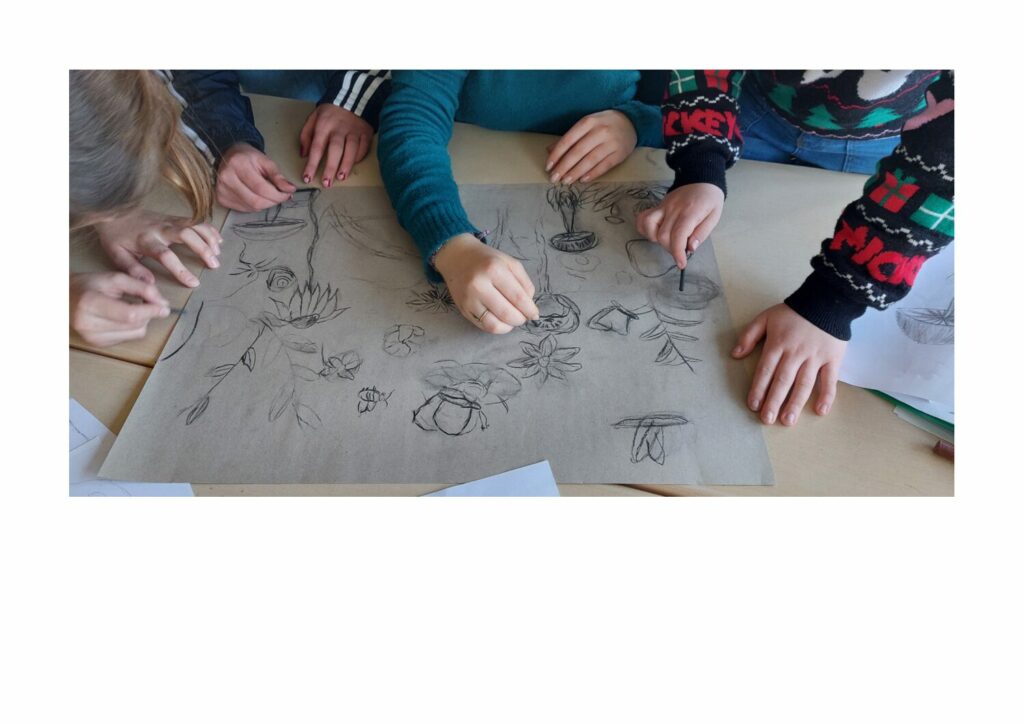
The focus of the “Wiesenland” project week for 22 pupils from Year 6 was the presentation of the habitat. All the pupils chose animal and plant inhabitants of the meadow and practiced depicting them with different drawing materials (pencil, marker, charcoal), abstracting them and drawing them to fill an A4 sheet of paper.
Then 7 small groups each worked on a charcoal sketch of the meadow in A2 size, taking into account composition, perspective, diversity and proportions. The pupils drew their motif together on a sheet of paper (50×70 cm or 50×35 cm) and painted it in gouache. Every single step from the sketch to the colored picture was explained. The result was seven large-format meadow pieces, which will soon be framed and displayed in the school corridor.
Artistic direction: Anekatrin Müller
J.G. Borlach – Community school in Bad Dürrenberg
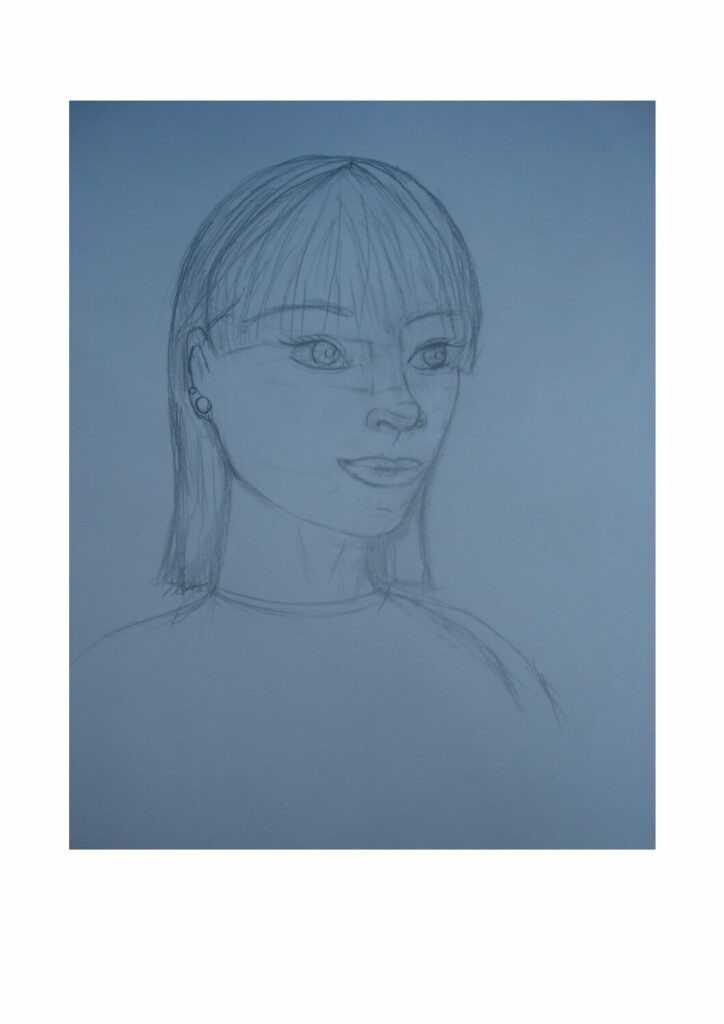
The project was carried out with the J. G. Borlach Community School in Bad Dürrenberg. A total of 48 pupils from a 9. and one 10th graders took part. The pupils worked intensively on portraits and interiors.
Most of the pupils worked on a self-portrait. But they could also draw each other. Afterwards, they should work in color using a technique of their choice. It did take some time to bring the spatially seen onto the surface. The assistance and corrections were gratefully received.
The corridors and stairwell were available for the interior. If possible, figures should also be integrated.
Artistic direction: Sibylle Mundt
Albrecht Dürer School in Halle
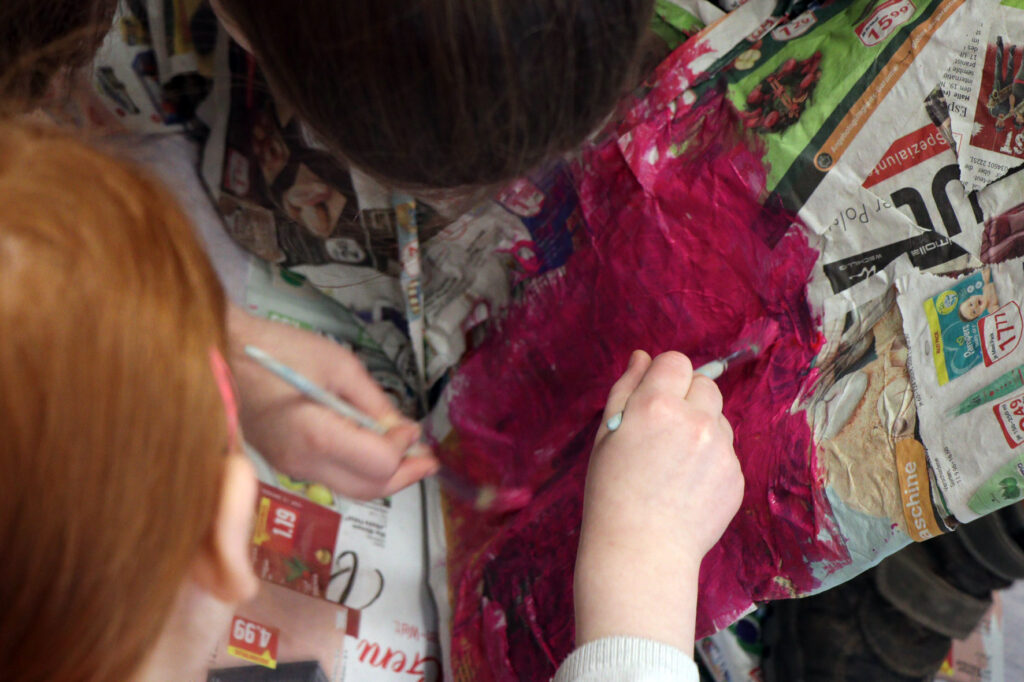
The Halloween festival was the starting point for the project. After dealing with this popular event, the focus was on the plastic production of monsters. By dividing the 3rd grade into 4 groups, they created meter-sized, different creatures from rabbit wire, newspaper, paste and paint. They have been developed from the pupils’ designs.
So that each group could concentrate on its monster, each group was assigned a specific habitat by drawing lots. The result was a water, air, land and earth creature. Working together as a team on the large sculptures was a particular challenge.
Artistic direction: Petra Reichenbach
J.-W.-v.-Goethe secondary school in Ilsenburg
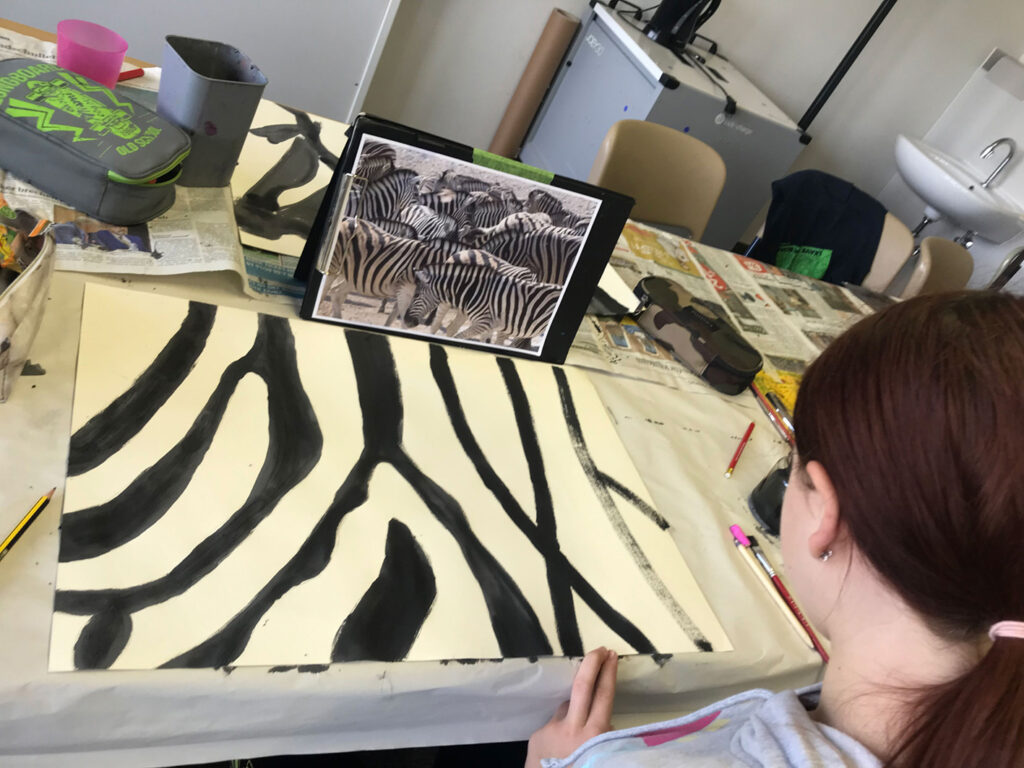
In the “Animal in focus” workshop, we played with distance and proximity (whole animal versus detail) and became creators of new animal combinations.
Colored animal photos from my trip to Africa served as templates for the abstract graphic pattern that the young people painted with black ink. The outlines of other animals were drawn on the backs of these sample sheets, cut out and arranged into graphic collages within a black frame – for viewing through binoculars.
Artistic direction: Reneé Reichenbach
Levana School in Eisleben
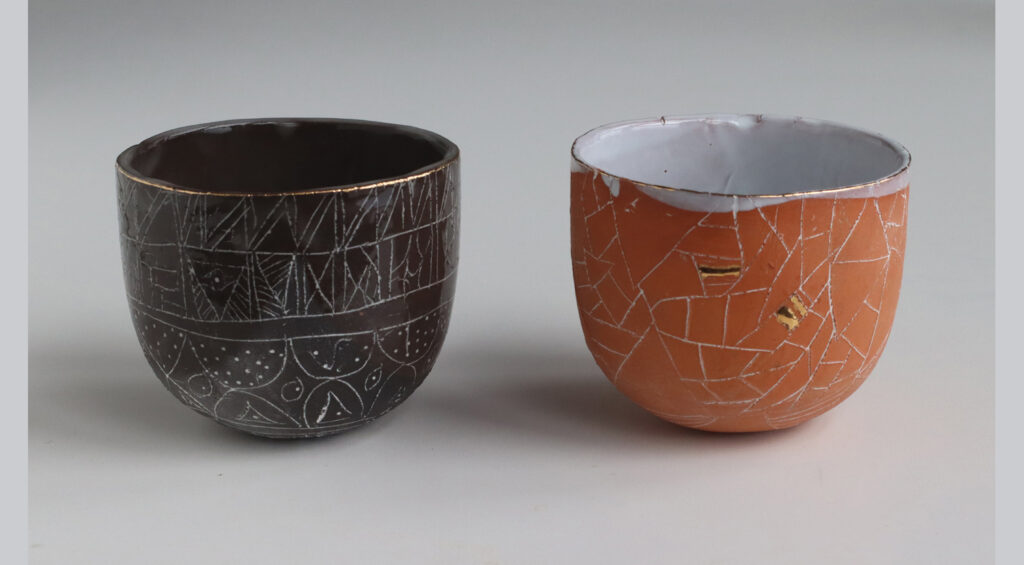
Two groups of pupils made small clay pots decorated with geometric ornaments or freely decorated. They experienced the working process from beating the clay to rolling it into slabs, cutting it to size and shaping it into various plaster molds.
The preliminary drawing, scratched with a fine needle, served as a framework for colored engobe painting. The combination of delicate engraving and bold brushstrokes created intense, highly individual, small works of vascular art.
Artistic direction: Katrin Röder
Thomas Müntzer” grammar school in Halle

The aim was to combine the pupils’ own creativity with the theme of wanderlust.
The idea was to create a collage graphic with an airship/balloon/zeppelin for a fictional story of their own.
The students filled the background with “weather” and large areas of the flying object on kraft paper with at least 3 tempera colors. Graphic elements such as garlands, emblems and isobars were added with fineliner and colored pencil. 5 collage objects such as birds, insects or shells and a human figure completed the design.
Artistic direction: Pauline Ullrich
Protestant elementary school “Martin-Luther” in Oppin

Children’s hands and color – they are colorful, the corals – cheeky and joyful. The garbage is nothing less than “dirt”, no longer recognizable as such in all its colourful splendour. The children’s joy in doing and the new sense for the seemingly nonsensical affects the observer and in turn becomes a joy for me as an artist. If only the other garbage and nonsense could find such an easy and playful form!
Artistic direction: Grit Wendelberger
Primary school/after-school care center Bergschule in Bad Kösen
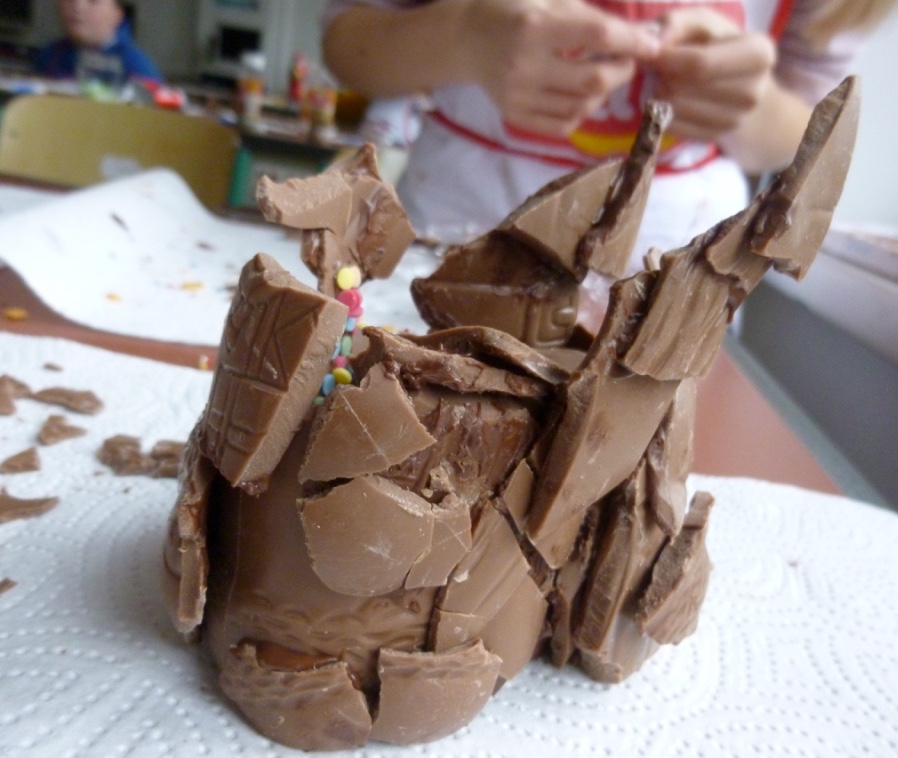
Around 35 pupils from the first to fourth grades enjoyed a creative culinary autumn break: on the theme of “Eat Art”, they worked on the basic techniques of working with the plastic material chocolate paint on an edible surface: gluing, collaging, drawing, designing colored surfaces, painting…
Delicious paintings were created on canvases based on various fairy tales, which will decorate the school’s dining room as a painted, continuous story book.
The children made a mini city out of Santas, boats and archaeological finds out of milk chocolate. This was inspired by a story about Santa Claus.
We really enjoyed it and as a thank you to everyone, we gave them a recipe for homemade drinking chocolate to make themselves.
Artistic direction: Katrin Zickler
Philanthropinum grammar school in Dessau

Under the motto “Out and about in the city park with pen and ink”, 12 seventh and eighth graders from the Philanthropinum grammar school in Dessau took the opportunity to develop their drawing skills. In addition to drawing outdoors, the focus was on the technique of pen and ink drawing.
An introduction to the technique by artist Katrin Zickler was followed by the first exercises. Having gained confidence in using pen and ink, the first drawings were made on location in the city park. 5-minute drawings promoted perception and a reproduction of the motifs reduced to essential elements.
All participants found the individual work directly in front of the motifs very enriching and exciting. The introductions to the techniques of white heightening, washing and coloring with watercolor offered by the artist were very well received by the students and were enthusiastically implemented in their pen and ink drawings.
Artistic direction: Ines Zimmermann
Special school for the mentally handicapped “Hugo-Kükelhaus” in Magdeburg
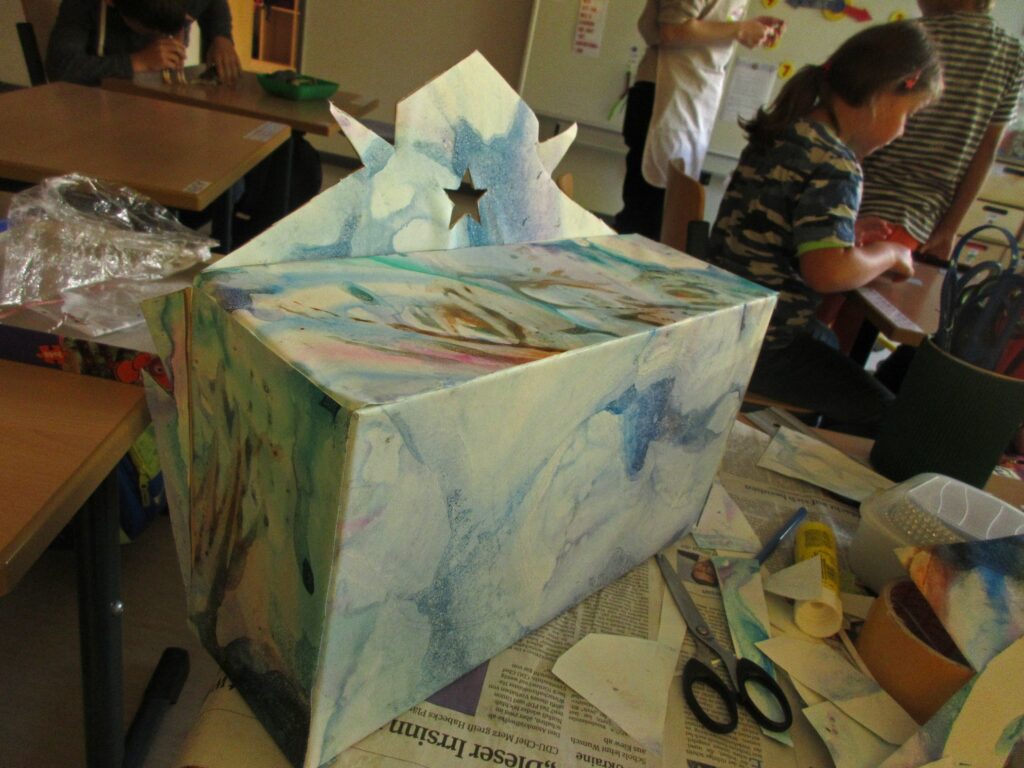
The art project at the “Hugo Kükelhaus School” created theater out of shoe boxes.
The children’s individual lives could be portrayed and acted out through this theater. The outer lining of the boxes was made of paper with beautiful color gradients. Watercolor paper was colored with foam paint. The interior cladding was realized with pictures in scratch technique.
Each theater received 2 backdrops drawn with wax crayons. The figures – representing family, friends and even pets – were created with colored pencils and then attached to guide rods. Particular attention was paid to the stage openings, which were made especially beautiful by crowning them with extravagant shapes and decorating them with glittering stones.
